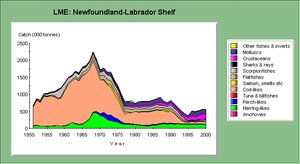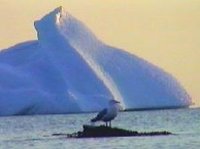Newfoundland-Labrador Shelf large marine ecosystem
Contents
Introduction Map of Newfoundland-Labardor Shelf. (Source: NOAA (Newfoundland-Labrador Shelf large marine ecosystem) )
The Newfoundland-Labrador Shelf Large Marine Ecosystem (LME) extends to quite a distance off the eastern coast of Canada, encompassing the areas of the Labrador Current and the Grand Banks. The seabed of the Shelf is structurally complex. As in some other LMEs, over-exploitation is the principal source of changes within this LME, although fluctuations in the ocean climate have also been implicated. The ability to explain the dynamics of this LME is severely limited by the lack of time series of data on living components of the system except for a few species of fishes and seals.
Productivity
The Newfoundland-Labrador Shelf LME is considered a Class II, moderately productive (150-300 gC/m2-yr), ecosystem based on SeaWiFS global primary productivity estimates. For productivity information, read the GLOBEC Working Group Summary of the Newfoundland and Labrador Shelves for productivity information. Harsh environmental conditions, extensive and persistent sea ice, extreme cold anomalies, changes in distribution of the area occupied by the Cold Intermediate Layer (CIL), all contributed in some manner to population collapses in fisheries (see next section) in the 1990s. The species of invertebrates that have increased the most are favored prey of cod and other collapsed major predators. The new population densities that have appeared may have redistributed energy flows in ways that have made it difficult to return to earlier system configurations. With regard to plankton dynamics there have been several local studies (see Prasad and Haedrich 1993). There was a continuous plankton recorder (CPR) transect through this area in the 1950s to the 1970s, but this transect was discontinued in the early 1970s.
Fish and Fisheries
 Newfoundland-Labrador Shelf Graph. (Source: NOAA)
Newfoundland-Labrador Shelf Graph. (Source: NOAA) Commercially exploited fish species include cod, haddock, salmon (see salmon stock assessment for 1997), American plaice, redfish, yellowtail and halibut. Also harvested are lobster, shrimp and crab. Historic record of catches of Atlantic cod can be reconstructed back to 1677 (see Forsey and Lear, 1987, for a time series of cod catches). These records, and other investigations, indicate that instability and variation characterized the entire history of exploitation of fisheries (Fisheries and aquaculture) off the coast of Newfoundland and Labrador. The LME has shown major changes over time. These changes have been greater in recent decades than in any other period in history. There was a rapid expansion of distant water fleets during the late 1950s, as well as an intensification of fishing effort. This affected the major fish stocks of the shelf (see Murawski, 1997). Overfishing of cod, haddock, redfish and major flatfish in the 1960s and 1970s led to fisheries collapses. The 1985-1993 fish collapses were different from the previous fisheries collapses and are hard to account for. Overfishing was aggravated by, and partly caused by, ecosystem dynamics. Even species as bycatch, such as witch flounder, have become overfished. There were declines in abundance of broadhead wolffish and thorny skate. The collapses led to a fishing moratorium in 1992. At the same time, other fisheries (notably crab) are experiencing record yields. For a stock by stock assessment and recommendation, see Canada’s Department of Fisheries and Oceans website . The University of British Columbia Fisheries Center have detailed fish catch statistics for this LME. Rice (2002) discusses changes to the Newfoundland-Labrador Shelf LME.
Pollution and Ecosystem Health
 (Source: NOAA)
(Source: NOAA) There have been outbreaks of Okiopleura blooms. The International Cod and Climate Change Program (CCC) studies the response of different cod [[population]s] to climate changes in various regions of the cod’s North Atlantic range. Canada is a key participant in SCOR (Scientific Committee for Ocean Research) and ICES (International Commission for Exploration of the Sea).
Socioeconomics
The Grand Banks of Newfoundland and Labrador have been fished since the 1400s, with fleets arriving annually from many of the fishing nations of Europe. The banks and [[coast]al areas], being rich and productive, formed the basis for settlement. The Atlantic cod fishery was the key of the economy. With the collapse of the cod fishery and its associated economy, approximately 30,000 people have been adversely affected. However, recent increases in the value of crab and shrimp landings are approaching the annual value of the cod fishery. For aboriginal affairs, see Canada’s Department of Fisheries and Oceans (DFO) website.
Governance
 (Source: NOAA)
(Source: NOAA) Canada and France (the islands of St. Pierre et Miquelon) share jurisdiction of this LME. Canadian fisheries after 1945 were regulated under ICNAF (International Commission for the Northwest Atlantic Fisheries), consisting of all the industrialized fishing nations of the world operating in that area. ICNAF’s effectiveness, however, was limited by the voluntary nature of compliance to its rules. The limited development of Canada’s domestic fleet prompted Canada to establish a 200-mile Exclusive Economic Zone in 1977, which effectively excluded foreign fleets from most of the Grand Banks. Single species quota management continues. While there is a stated desire to change to an ecosystem level approach, there are no explicit objectives within fisheries management plans for the remainder of the ecosystem. This ambiguity in management objectives underscores the need for the many single function management agencies to be integrated. For a review of Canada's plans, see the sustainable development strategy.
References
- Charting a new course: Towards the fishery of the future. 1993. Report of the task force on incomes and adjustment in the Atlantic fishery. Communications Directorate, Fisheries and Oceans, Ottawa, Ontario. 199 pp. ISBN: 0662600525.
- Forsey, R and W.H. Lear. 1987. Historical Catches and Catch Rates of Atlantic Cod at Newfoundland during 1677-1833. Can. Data Rep. Of Fish. and Aquat. Sce. 662. 52 p.
- Murawski, S.A., J.-J. Maguire, R.K. Mayo, and F.M. Serchuk. 1997. Groundfish stocks and the fishing industry. In: J. Boreman, B.S. Nakashima, J.A. Wilson, and R.L. Kendall (eds.). Northeast Atlantic Groundfish: Perspectives on a Fishery Collapse. Am. Fish. Soc. Washington, DC. 27-69.
- Prasad, K.S. and R.L. Haedrich, 1993. Satellite observations of phytolankton variability on the Grand Banks of Newfoundland during a spring bloom. Int. J. Remote Sens. 14:241-252.
- Resources of the Sea Conference: Fish and Oil. 1973. The Extension Service, Memorial University of Newfoundland and The Canadian International Development Agency. Two volumes.
- Rice, Jake, 2002. Changes to the Large Marine Ecosystem of the Newfoundland-Labrador Shelf, In K. Sherman and H.R. Skjoldal, eds. Large Marine Ecosystems of the North Atlantic—Changing States and Sustainability. Elsevier. 51-104. ISBN: 0444510117.
- Rivard, D., W.D. McKone, and R.W. Elner. 1988. Resource prospects for Canada's Atlantic fisheries: 1989-1993. Communications Directorate, Fisheries and Oceans, Ottawa, Ontario. 270 pp.
- Scarratt, D.J. (Ed.). 1982. Canadian Atlantic offshore fishery atlas. Can. Spec. Publ. Fish. Aquat. Sci. 47 (Revised). 101 pp.
- Sinclair, Peter R. (Ed.). 1988. A question of survival: The fisheries and Newfoundland society. Social and Economic Papers No. 17. Institute of Social and Economic Research, Memorial University of Newfoundland. 254 pp.
| Disclaimer: This article is taken wholly from, or contains information that was originally published by, the National Oceanic and Atmospheric Administration (NOAA). Topic editors and authors for the Encyclopedia of Earth may have edited its content or added new information. The use of information from the National Oceanic and Atmospheric Administration (NOAA) should not be construed as support for or endorsement by that organization for any new information added by EoE personnel, or for any editing of the original content. |